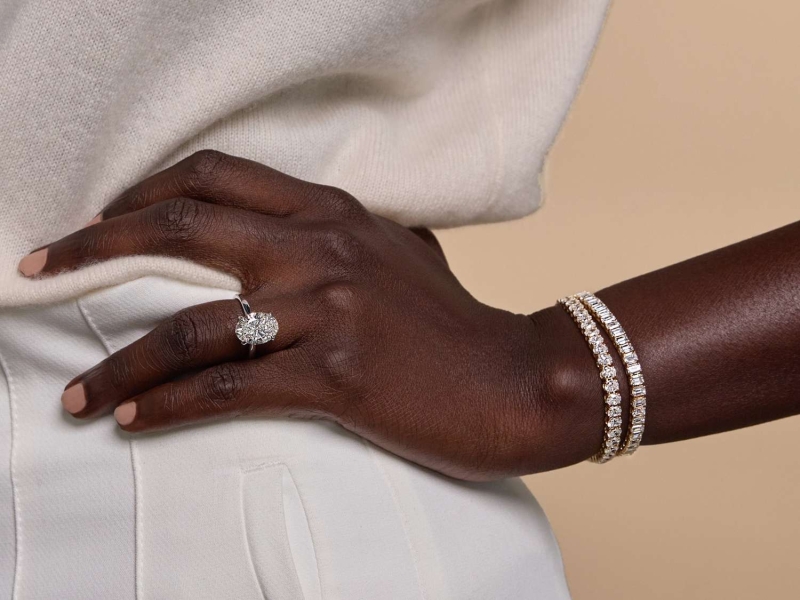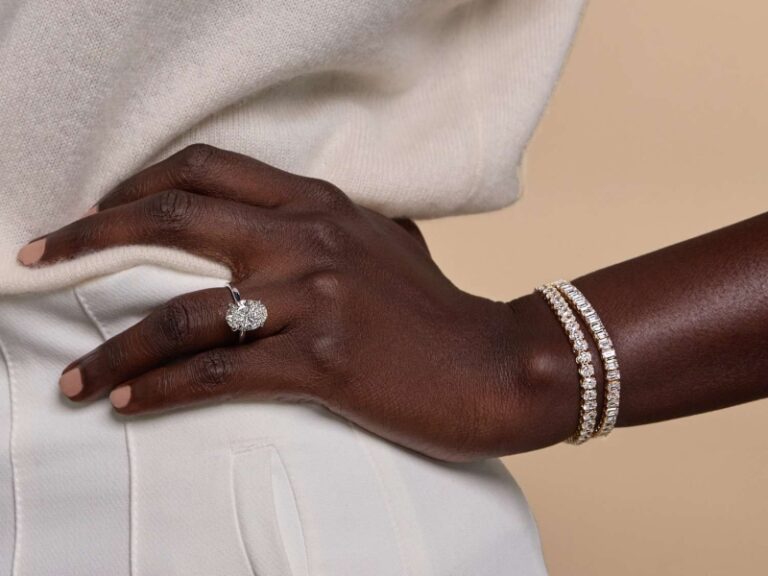
Natural vs. Lab-Grown Gemstones The Best Pieces to Shop The Final Takeaway
Nothing is quite as exquisite, meaningful, and singular as fine jewelry. The art form dates back to the Paleolithic era (around 2.58 million years ago), and to this day, jewelry is one of the most important and fulfilling investments. We wear it close to our hearts, brains, and pulse points, using it to symbolize and mark significant milestones in life, from birthdays to graduations to weddings. There are countless ways to categorize jewelry, and one of the latest innovations—lab-grown gemstones—is providing a more sustainable, affordable alternative to natural diamonds that’s quickly catching on as an industry trend. If you’re wondering what we’re even talking about or which you should opt for next time you’re shopping for a new piece, you’ve come to the right place: Ahead, see our guide to lab-grown gemstones, complete with insights from three jewelry experts.
What Are Lab-Grown Gemstones?
Simply stated, lab-grown gemstones are created in laboratories, while natural stones are formed in the earth over the course of billions of years. Lab-made (or synthetic) diamonds grow from a tiny diamond “seed” that’s placed in uber-high heat and immense pressure. “Lab-grown gemstones are precious and semi-precious stones that are cultivated in controlled laboratory conditions using a process that simulates the same environmental pressures and temperatures that result in the formation of natural gemstones beneath the Earth’s surface,” explains Grown Brilliance founder and creative director Akshie Jhaveri.
To the naked eye, lab-grown and natural stones look pretty much identical—their differences mostly lie in their aura and origins. Lab-grown stones have the same sparkle, quality, and overall appearance as their natural counterparts: “The only difference between lab-grown and mined diamonds is the origin," says jewelry founder Jean Dousset. "The…beauty and brilliance remain the same no matter where it comes from." Brilliant Earth SVP of merchandising and retail expansion Kathryn Edison Money adds that lab-grown stones “have the same consistency in color, quality, and hardness that natural gemstones do. Because they grow in a controlled environment, lab-created gemstones have [few], if any, flaws.”
History of Lab-Grown Jewelry
For the last few years, lab-grown stones have saturated the airwaves and the market. But while it may seem like they've suddenly popped up everywhere out of thin air, they’ve actually been brewing and crystallizing for decades.
Lab-grown stones “speak to the incredible marriage between science and art, but also [to] the evolution of the conscious consumer in the luxury space,” Jhaveri tells us. “The inception of lab-grown diamonds traces back to the 1950s, when scientists at General Electric first managed to create them under high-pressure, high-temperature (HPHT) conditions, but of industrial-grade quality. It wasn't until the late 1980s that the process was refined enough to produce gem-quality diamonds."
When lab-grown gemstones became possible, "This marked a monumental shift in the world of gemstones—we were not just talking about diamonds anymore, but also colored stones like sapphires, rubies, and emeralds," Jhaveri adds. "With the turn of the century, lab-grown jewelry started getting more high-profile attention with the evolution of the conscious consumer."
Now, lab-grown gemstones have a more prominent, respected place in the jewelry industry than ever. "In 2016, the Federal Trade Commission (FTC) gave lab-grown jewelry [a stamp of approval] when they officially recognized lab-grown diamonds as, well, diamonds," Jhaveri tells us. "No more 'synthetic' or 'man-made' tags are now needed.”
Pros and Cons
When it comes to choosing between natural or lab-grown gemstones, it’s completely a matter of personal preference and what you consider a priority. The pros and cons of each are outlined below:
Lab-Grown Gemstones
Pros
- Accessible price point: Lab-grown gemstones are, in almost all cases, more affordable.
- Appeals to ethical concerns: Jhaveri notes that “lab-grown diamonds really speak to this new generation of conscious consumers,” as they’re more accessible and reputable jewelers use ethical practices. "Lab-grown diamonds can be a responsible choice since they are grown with precise technology that involves no mining,” Money adds.
- Good quality and appearance: “Without specialized equipment, you won't be able to tell the difference between a lab-grown or a natural diamond—they appear the same," Money says. "Lab-created diamonds may exhibit different trace elements than natural diamonds that do not affect the appearance of the diamond.”
All in all, “lab diamonds are a revolution for the industry," Dousset says.They bring access and affordability to the most loved and admired gemstone without the financial burden that restricted so many from acquiring what they desired, whether the size, quality, or both. Only a select few could really have it all until now—they are very much still a luxury product and purchase, and they retain the same meaning and sentimental value.”
Cons
- Lower resale value: Like technological devices, lab-grown stones are exciting, and more of them are coming into existence every day—so they can lose most of their value quickly. Should you want to sell, appraise, or trade up a lab-grown stone in the future, you’ll likely find that it’s worth a fraction of what you originally paid for it.
- Cultural perception: Lab-grown stones don't have the same aura, history, and rarity as natural gems. Natural stones come from the earth and are seen as ancient, miraculous treasures, and lab-grown stones haven't achieved that reputation due to the fact that any laboratory with the right capabilities can create them.
- Ethics aren't always clear: There can be greenwashing in the lab-grown stone space—not all labs are environmentally friendly, and as with all factories, labor practices aren’t ethical by default. If you’re buying a lab-made stone, be sure to look into the company’s practices and certifications.
Natural Gemstones
Pros
- Sentimental value: There’s something inimitable about owning and wearing a miraculous stone that was formed in the earth over billions of years. They’re harder to come by, have marked historical significance, and are earthly artworks. This makes them a great choice if you're looking for an incredibly special piece to mark an occasion.
- Lasting monetary value: Natural diamonds always have been and always will be rare and prized, and they become more valuable with time.
- Improving practices: Mining can and should be done ethically. With the rising popularity of lab-grown stones and the growing consciousness of consumers across all marketplaces, stone dealers and jewelry companies are becoming more transparent—and some jewelers have focused on ethical sourcing for many decades.
Cons
- Inconsistent ethics: Historically, unethical practices have been used in mines, and mining can be dangerous and destructive. If you’re purchasing a jewelry with natural diamonds or gemstones, be sure to buy only from designers and jewelers who source their materials from ethical, transparent, environmentally friendly sources. A trustworthy jeweler will be able to provide you with information behind the stone, and typically a certificate.
- Higher price point: Because of how rare they can be, diamonds and other gemstones can be fairly expensive. This makes them less accessible if you’re looking for a more casual piece or something you don’t anticipate wearing enough to justify the price.
Natural vs. Lab-Grown Gemstones
Both are real diamonds, made entirely of carbon—the differences are, again, in origin and age. Natural diamonds form on their own, and lab-grown diamonds are created in a lab. A natural diamond takes billions of years to form—a process that takes place from immense natural pressure that's applied to carbon, miles below the surface of the earth. A lab-grown diamond can go from seed to completion over the course of three to six weeks.
The four Cs of grading a natural diamond (color, cut, clarity, and carat), are also used for lab-grown diamonds, and because they’re man-made, it’s easier to find a flawless lab-grown diamond than it is a natural stone. A completely flawless natural diamond is rarer, which adds monetary and symbolic value.
As far as the environmental impacts and carbon footprints of natural and lab-made stones, there are no black-and-white answers. Factors like mining conditions, chemicals, and transportation all need consideration, and this varies greatly from source to source. If protecting and supporting the environment is a priority, the most sustainable action that you can take when selecting a stone is choosing a vintage or repurposed piece from an ethical source.
The Best Lab-Grown Jewelry Pieces to Shop Now
As we mentioned, the lab-grown jewelry industry is booming, with a constantly growing number of diamonds and other gemstones available in a range of settings and pieces. If you’re sold on lab-grown diamonds and stones, check out a few of our favorite pieces.
The Final Takeaway
When it comes to choosing between natural and lab-grown stones, there’s truly no objectively better answer: It’s completely a matter of your priorities and personal preference. If you’re looking for a more affordable option, want to make sure your stone is ethically sourced without too much searching, or want a flawless stone for a lower cost, a lab-grown stone may be ideal for you. If you’re more interested in a special, ultra-luxe piece with history and a value that appreciates with time, a natural stone is your top choice.
Should you choose to go the natural route, make sure you’re buying from a reputable jeweler who sources their stones from planet-friendly, ethical gemstone dealers. The right jewelers will care as much as you do, and will often have certificates for their stones. Regardless of which you choose, rest assured that it’ll bring stunning brilliance to every facet of your life.

